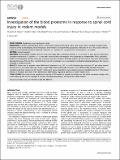Files in this item
Investigation of the blood proteome in response to spinal cord injury in rodent models
Item metadata
| dc.contributor.author | Hulme, Charlotte H | |
| dc.contributor.author | Fuller, Heidi R | |
| dc.contributor.author | Riddell, John | |
| dc.contributor.author | Shirran, Sally L | |
| dc.contributor.author | Botting, Catherine H | |
| dc.contributor.author | Osman, Aheed | |
| dc.contributor.author | Wright, Karina T | |
| dc.date.accessioned | 2021-10-13T14:30:15Z | |
| dc.date.available | 2021-10-13T14:30:15Z | |
| dc.date.issued | 2021-10-02 | |
| dc.identifier | 276266220 | |
| dc.identifier | 44ea8370-d112-4416-9529-c3ad96f2c4fe | |
| dc.identifier | 85116347224 | |
| dc.identifier | 000702800200001 | |
| dc.identifier.citation | Hulme , C H , Fuller , H R , Riddell , J , Shirran , S L , Botting , C H , Osman , A & Wright , K T 2021 , ' Investigation of the blood proteome in response to spinal cord injury in rodent models ' , Spinal cord , vol. First Online . https://doi.org/10.1038/s41393-021-00692-8 | en |
| dc.identifier.other | RIS: urn:90E65BECB0C2557DD91A102941021D66 | |
| dc.identifier.other | ORCID: /0000-0003-3516-3507/work/101581458 | |
| dc.identifier.uri | https://hdl.handle.net/10023/24134 | |
| dc.description | We would like to thank the Institute of Orthopaedics and the Midlands Centre for Spinal Cord Injury (MCSI) for funding this research. This work was also supported by the Wellcome Trust [grant number 094476/Z/10/Z] which funded the purchase of the TripleTOF 5600 mass spectrometer at the BSRC Mass Spectrometry and Proteomics Facility, University of St Andrews. | en |
| dc.description.abstract | Study Design: Explanatory and mechanistic study. Objective: A better understanding of the 'whole-body' response following spinal cord injury (SCI) is needed to guide future research aimed at developing novel therapeutic interventions and identifying prognostic indicators for SCI. This study aimed to characterise the blood proteome following contusion or complete SCI compared to a sham injury in rat models. Setting: United Kingdom. Methods: Pooled blood samples from one and seven days after a contusion (serum; n = 5) or from 14 days and 112 days post-complete transection SCI (plasma; n = 8) and their sham-injured counterparts were subjected to independent iTRAQ nanoflow liquid chromatography tandem mass-spectrometry proteomic analyses. Pathway analyses of the proteins that were differentially abundant between SCI and their matched sham injured counterparts were completed to indicate biological pathways that may be changed in response to SCI. Results: Eleven and 42 proteins were differentially abundant (≥±2.0 FC; p ≤ 0.05) between the contusion SCI and sham injured animals at 24 h and seven days post-injury, respectively. Seven and tweleve proteins were differentially abundant between complete and sham injured rats at 14 and 112 days post-injury, respectively. Acute-phase response signalling and Liver X Receptor/Retinoic X Receptor activation were identified as differentially regulated pathways in both models of SCI. Conclusions: We have utilised longitudinal preclinical SCI models to provide an insight into the blood proteome changes that result following SCI and to highlight a number of biological pathways of interest for future studies. | |
| dc.format.extent | 6 | |
| dc.format.extent | 521805 | |
| dc.language.iso | eng | |
| dc.relation.ispartof | Spinal cord | en |
| dc.subject | QH301 Biology | en |
| dc.subject | RC0321 Neuroscience. Biological psychiatry. Neuropsychiatry | en |
| dc.subject | DAS | en |
| dc.subject.lcc | QH301 | en |
| dc.subject.lcc | RC0321 | en |
| dc.title | Investigation of the blood proteome in response to spinal cord injury in rodent models | en |
| dc.type | Journal article | en |
| dc.contributor.sponsor | The Wellcome Trust | en |
| dc.contributor.institution | University of St Andrews. School of Biology | en |
| dc.contributor.institution | University of St Andrews. Biomedical Sciences Research Complex | en |
| dc.contributor.institution | University of St Andrews. School of Chemistry | en |
| dc.identifier.doi | 10.1038/s41393-021-00692-8 | |
| dc.description.status | Peer reviewed | en |
| dc.identifier.grantnumber | 094476/Z/10/Z | en |
This item appears in the following Collection(s)
Items in the St Andrews Research Repository are protected by copyright, with all rights reserved, unless otherwise indicated.

